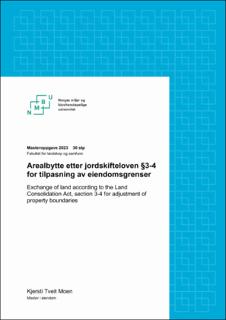| dc.description.abstract | Tema for denne masteroppgaven er muligheten og behovet en tiltakshaver har til å benytte arealbytte for å tilpasse eiendomsgrense til reguleringsplan. Målet med oppgaven er å belyse forskjellige situasjoner det kan bli aktuelt å benytte jordskifteretten fremfor forvaltningen. Arealbytte gir mulighet til å endre eiendomsgrensene slik at de samsvarer med reguleringsplan, men det finnes likevel lite rettspraksis på dette.
Hovedproblemstillingen lyder følgende «hvilke behov og mulighet har tiltakshaver til å benytte arealbytte etter jordskifteloven til å tilpasse eiendomsgrenser til reguleringsplan?». Hovedproblemstillingen besvares gjennom tre delproblemstillinger:
*
1) Kommunens saksgang- hvordan oppleves den av utbyggere? Hvilke mangler/utfordringer er det ved den kommunale ordningen og hvilke økonomiske og praktiske konsekvenser kan disse medføre?
*
2) Hvilke utfordringer og muligheter finnes ved bruk av arealbytte etter jordskifteloven?
*
3) I hvilken grad kan jordskifteretten erstatte kommunens saksgang?
For å svare på hovedproblemstillingen har jeg valgt å benytte meg av ett kvalitativt studie, ved å innhente empiri fra rettsbøker og intervju av ansvarlige søkere og byggesaksbehandlere.
Manglene samsvar mellom eiendomsgrenser og reguleringsplaner er vanlig i utbyggingsprosjekter. Og i de aller fleste tilfeller benyttes kommunen for å oppnå samsvar. Arealbytte blir benyttet i liten grad, dette kommer i hovedsak av at det er sjeldent det er behov eller at saken ikke er egnet for jordskifteretten. For tiltakshaver er tid og risiko ved eiendomsdannelse sentralt, en jordskiftesak tar både lang tid og resultatet er usikkert. Det er likevel flere momenter ved sak som kan gjøre den aktuell for jordskifteretten. Momenter som øker attraktiviteten er prosjektets omfang, hvor det er behov endre mer enn kun grensene. En situasjon hvor målet er å unngå skatt og avgift. Dersom prosjektet ikke opplever tidspress. Ved tvist eller mistanke om at det vil oppstå tvist. Om sakene er bestående av at ett større område som gir jordskifteretten flere mulige jordskifteavgjørelser. Eller er en mindre utbygger som ønsker å unngå den kommunale behandlingen.
Informantene som har benyttet jordskifteretten tidligere er fornøyde med resultat og saksgangen, dette er også grunnen til at de fortsetter å benytte jordskifteretten. Jordskifterettens vilkår, virkemidler og prosess bør bli bedre kjent blant tiltakshavere og kommunalt ansatte. På den måten kan jordskifteretten bidra til å skape mer hensiktsmessige løsninger gjennom en effektiv og samlet saksprosess. | |
| dc.description.abstract | The theme of this master's thesis is the possibility and necessity for a developer to use land exchange to adjust property boundaries to comply with a zoning plan. The aim of the thesis is to highlight the different situations in which a developer may use the land consolidation court instead of the government. Land exchange allows for the modification of property boundaries to align with the zoning plan, but there is currently little legal precedent on this matter.
The main research question is "What are the needs and opportunities for a developer to use land exchange under the Land Consolidation Act to adjust property boundaries to comply with a zoning plan?" This research question is answered through three sub-questions:
*
1) What is the municipality's procedure, and how is it perceived by developers? What are the shortcomings/challenges of the municipal process, and what are the economic and practical consequences of these shortcomings?
*
2) What are the challenges and opportunities associated with using land exchange under the Land Consolidation Act?
*
3) To what extent can the land consolidation court replace the municipality's process?
To answer the main research question, a qualitative study is conducted, gathering empirical data in the form of legal texts and interviews with responsible applicants and municipal employee.
Inconsistencies between property boundaries and zoning plans are common in development projects. In most cases, the municipality is used to achieve consistency. Land exchange is used to a limited extent, mainly because there is rarely a need for it, or the case is unsuitable for the land consolidation court. Time and risk are central to a developer's property formation, as a land consolidation case takes a long time and the outcome is uncertain. However, there are several factors that can make the case suitable for the land consolidation court. Factors that increase attractiveness include the scope of the project, where there is a need to change more than just the boundaries, a situation where the goal is to avoid taxes and fees, lack of time pressure, disputes, suspicion of disputes, cases consisting of a larger area that provides the land consolidation court with multiple land consolidation decisions, or a smaller developer who wants to avoid municipal treatment.
4
Informants who have used the land consolidation court before are satisfied with the outcome and process, which is why they continue to use the court. The terms, tools, and processes of the land consolidation court should be better known among developers and municipal employees. In this way, the land consolidation court can contribute to creating more appropriate solutions through an efficient and unified process. | |
